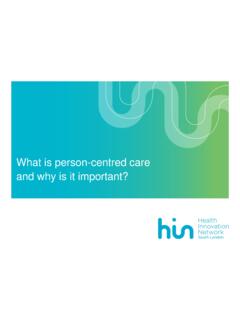Transcription of Interview, Selection and Offer Management Best …
1 1 interview , Selection and Offer Management best Practice Guide 2 Contents 1. Longlisting and Shortlisting .. 4 Why do I need to complete longlists and shortlists? .. 4 What is the difference between a longlist and a shortlist? .. 4 How should I approach longlisting? .. 4 How should I approach shortlisting? .. 4 What if two or more of my candidates have the same shortlisting score? .. 5 best Practice on Reserve Lists: .. 5 2. Designing Selection Format .. 6 What is Selection format? .. 6 Which type of Selection format will be most appropriate for the internship role? .. 6 3. Designing interview Questions .. 12 Practicalities .. 12 What can I assess via interview ?
2 12 How can I effectively assess candidates who are typically likely to have less workplace experience? .. 12 Types of interview Questions: .. 13 Biographical Questions: .. 13 Strengths-Based interview Questions: .. 13 Motivational interview Questions: .. 13 Situational interview Questions: .. 14 4. At the interview .. 15 Pre-Meeting .. 15 During interview FAQ: .. 15 What should I do if a candidate is struggling to answer a question or has misunderstood it? .. 15 Should I provide a section at the end of the interview for candidates to ask any questions they have? .. 15 If I want to ask the candidate an additional question about information in their application ( a question that is not part of the planned interview format) when should I do this?
3 15 How can I reassure a candidate who is particularly affected by nerves? .. 15 What are the key points I need to cover in closing the interview ? .. 16 Can I get any other help running my interview process? .. 16 5. Scoring interview Questions .. 17 6. Post- interview review and deciding who to appoint .. 17 Does the panel need to make a decision straight away? .. 17 3 Should all panel members be present for the post- interview discussion and decision-making process? .. 17 What about a situation where the panel don t need to discuss the recruitment decision because there is a clear front-runner in the Selection process? .. 17 What about a situation where there is no clear front-runner or the panel is split?
4 18 7. Offer Management .. 19 4 1. Longlisting and Shortlisting Why do I need to complete longlists and shortlists? Where you have received a large number of applicants for a role, it will be important to have an effective evaluative process, by which you can decide which candidates to see for interview . This is important because: You will want to create a demonstrably fair Selection process, whereby you can justify decisions to see candidates for interview and more importantly, feedback to those who were not selected if requested to do so. You need to ensure you have the best possible chance of filling the role with an individual who is competent as per the person specification and therefore it is important to have a structure which informs your decision-making What is the difference between a longlist and a shortlist?
5 In a large group of candidates, a longlist is used to score each candidate against each of the Selection criteria to identify a ranking order in terms of which candidates meet which criteria and to what extent. This process can be used to eliminate candidates from the process who do not meet Selection criteria. A shortlist, uses the information produced in the longlisting process to identify which candidates scored highest in the longlisting process and should therefore be selected to be progressed to interview . How should I approach longlisting? You may want to use our standardised longlisting form (see toolkit doc ) to identify, in the case of each candidate s application, how well they meet each of the criteria in the person specification, that have been identified as criteria to be evaluated at application stage (as opposed to interview stage).
6 This is best approached by printing out and reviewing each application and then using the form to assess how much evidence each candidate has provided for each criteria. As this evaluative process can be subjective, it is advised that in the interests of fairness, a minimum of two separate individuals complete a longlisting process for a group of candidates. As this can be resource intensive, you may wish HIN to complete a comparative longlist or indeed, the full longlisting process for you. Once you have evaluated how well each candidate meets each criterion (2 separate evaluations for each candidate) you will then be ready to complete shortlisting. How should I approach shortlisting?
7 Prior to completing the shortlisting process, you will need to decide how many candidates you would like to see for interview . It is recommended, that you aim to identify, where possible, a minimum of three candidates per role to be progressed to the interview / assessment centre stage. Once you have decided how many candidates you would like to see, you will need to compare the two sets of data from the longlisting process to identify a rank order for candidates. Whilst there are various ways of establishing this order, a popular method is outlined below. Firstly, agree a standardised score for the extent to which each candidate meets each criterion. : o Criteria Fully Met= 3 points o Criteria Partially Met= 2 points 5 o Criteria Not Met= 0 points Once you have decided the above, work through each set of longlisting data for each candidate and add up their total score across the two shortlisters for all criteria Total score from first longlister + Total score from second longlister = Composite Longlisting Score Once you have a Composite Longlisting Score for each candidate, order these from highest to lowest, to identify the highest ranked candidates for interview .
8 What if two or more of my candidates have the same shortlisting score? In cases where two or more candidates have the same score, it is advisable to either: Consider interviewing both (they may be very evenly matched on paper) Use a third party to review the applicants in question and make a final decision Arrange for both of the original longlisters to meet to review the applicants in question and make a final decision. It may be that some of the criteria in the person specification are more important to the role than others and therefore, that candidates should be compared again against these specific criteria Once the above process is successfully completed, you should have a list of candidates to invite to interview .
9 You may also want to keep two to three candidates in reserve in case any of your shortlisted candidates withdraw from the process. best Practice on Reserve Lists: Where you are keeping candidates on a reserve list you may either wish to: With-hold contacting reserve list candidates until all shortlisted candidates have confirmed interview attendance Contact reserve list candidates to inform them that they have not been shortlisted for interview at this stage but that owing to their score during the shortlisting process, they are being held on a reserve list, should other higher scoring candidates withdraw from the process 6 2. Designing Selection Format What is Selection format?
10 The term Selection format is used here to describe the process by which shortlisted candidates are then evaluated in order for a decision to be made about who to appoint. According to the requirements of the post, this could include any or all of the following: - interview Process - Assessment Centre - Ability testing or other types of testing (as part of an assessment centre or separately) - Presentation (as part of the interview process) Which type of Selection format will be most appropriate for the internship role? In terms of best practice, an effective Selection process provides: a) A strong indicator of the abilities and potential of the shortlisted candidates to meet the criteria set out in the person specification for the role b) The opportunity for all candidates to be assessed in a fair and appropriate manner for the role concerned c) The ability to accommodate reasonable adjustments according to individual candidate needs as per the Equality Act 2010: All three of the above considerations are now discussed below.




